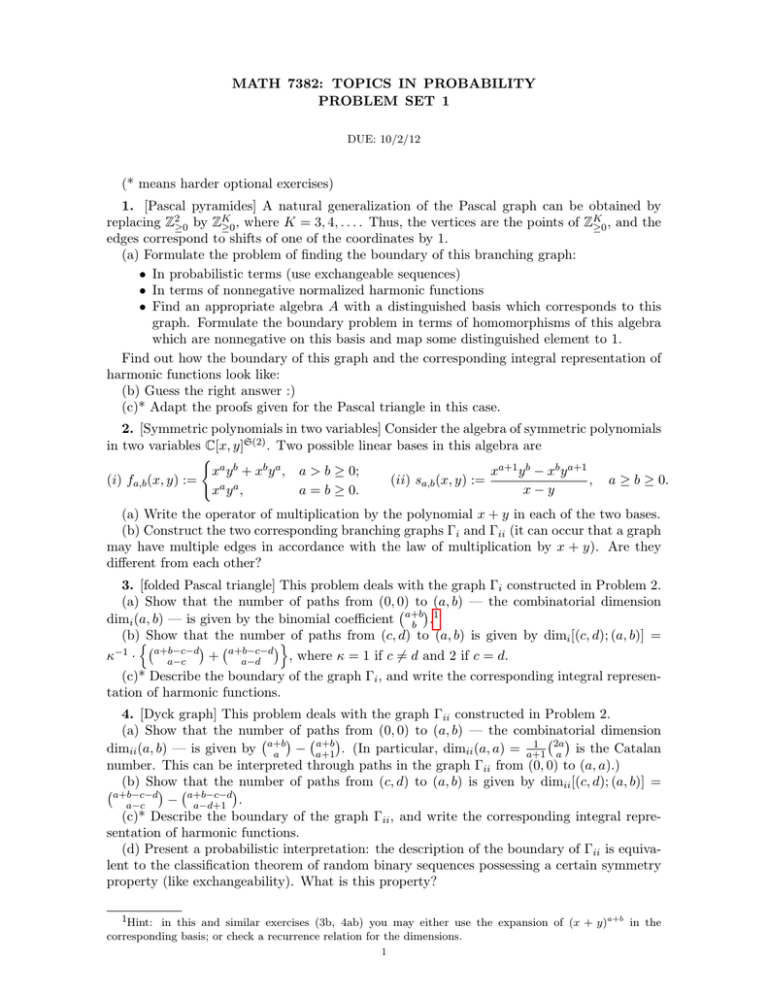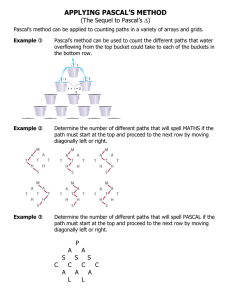MATH 7382: TOPICS IN PROBABILITY PROBLEM SET 1
advertisement

MATH 7382: TOPICS IN PROBABILITY PROBLEM SET 1 DUE: 10/2/12 (* means harder optional exercises) 1. [Pascal pyramides] A natural generalization of the Pascal graph can be obtained by K replacing Z2≥0 by ZK ≥0 , where K = 3, 4, . . . . Thus, the vertices are the points of Z≥0 , and the edges correspond to shifts of one of the coordinates by 1. (a) Formulate the problem of finding the boundary of this branching graph: • In probabilistic terms (use exchangeable sequences) • In terms of nonnegative normalized harmonic functions • Find an appropriate algebra A with a distinguished basis which corresponds to this graph. Formulate the boundary problem in terms of homomorphisms of this algebra which are nonnegative on this basis and map some distinguished element to 1. Find out how the boundary of this graph and the corresponding integral representation of harmonic functions look like: (b) Guess the right answer :) (c)* Adapt the proofs given for the Pascal triangle in this case. 2. [Symmetric polynomials in two variables] Consider the algebra of symmetric polynomials in two variables C[x, y]S(2) . Two possible linear bases in this algebra are ( xa y b + xb y a , a > b ≥ 0; xa+1 y b − xb y a+1 , a ≥ b ≥ 0. (i) fa,b (x, y) := (ii) s (x, y) := a,b x−y xa y a , a = b ≥ 0. (a) Write the operator of multiplication by the polynomial x + y in each of the two bases. (b) Construct the two corresponding branching graphs Γi and Γii (it can occur that a graph may have multiple edges in accordance with the law of multiplication by x + y). Are they different from each other? 3. [folded Pascal triangle] This problem deals with the graph Γi constructed in Problem 2. (a) Show that the number of paths from (0, 0) to (a, b) — the combinatorial dimension 1 dimi (a, b) — is given by the binomial coefficient a+b b . (b)nShow that the numbero of paths from (c, d) to (a, b) is given by dimi [(c, d); (a, b)] = −1 κ · a+b−c−d , where κ = 1 if c 6= d and 2 if c = d. + a+b−c−d a−c a−d (c)* Describe the boundary of the graph Γi , and write the corresponding integral representation of harmonic functions. 4. [Dyck graph] This problem deals with the graph Γii constructed in Problem 2. (a) Show that the number of paths from (0, 0) to (a, b) — the combinatorial dimension a+b a+b 1 2a dimii (a, b) — is given by a − a+1 . (In particular, dimii (a, a) = a+1 a is the Catalan number. This can be interpreted through paths in the graph Γii from (0, 0) to (a, a).) (b) Show thenumber of paths from (c, d) to (a, b) is given by dimii [(c, d); (a, b)] = that a+b−c−d a+b−c−d − a−d+1 . a−c (c)* Describe the boundary of the graph Γii , and write the corresponding integral representation of harmonic functions. (d) Present a probabilistic interpretation: the description of the boundary of Γii is equivalent to the classification theorem of random binary sequences possessing a certain symmetry property (like exchangeability). What is this property? 1Hint: in this and similar exercises (3b, 4ab) you may either use the expansion of (x + y)a+b in the corresponding basis; or check a recurrence relation for the dimensions. 1

